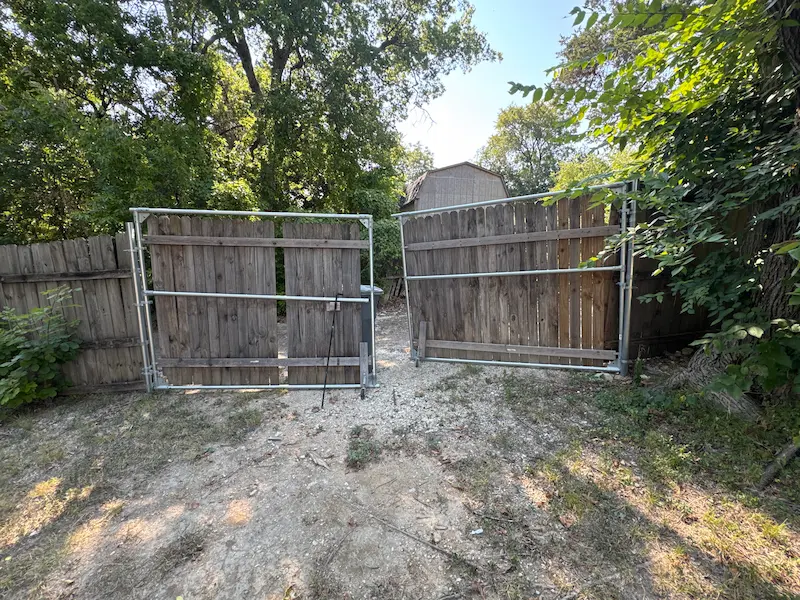If you’ve got a wood fence in Texas—especially around Arlington—you know it takes a beating. One week it’s sunny and dry, the next we’ve got thunderstorms, wind gusts, or even ice. All that weather drama doesn’t just mess with your weekend plans; it slowly wears down your fence, too.
But, with the right maintenance, you can keep your wood fence standing tall and looking great for decades. We’re going to walk you through the best ways to maintain your fence, how to spot and fix common problems, when to DIY and when to call in a pro, and how to make sure your fence lives a long, healthy life.
Why Fence Maintenance Even Matters
Your wood fence is more than just a boundary line—it gives you privacy, boosts curb appeal, keeps pets and kids in the yard, and adds value to your home. But wood is a natural material, and without proper care, it can warp, rot, crack, or become a snack for bugs. Taking care of it now prevents expensive repairs (or full replacements) later.
7 Practical Tips for Maintaining Your Wood Fence
1. Inspect It Regularly
Every few months—or right after a Texas storm rolls through—walk the fence line and take a good look. Keep an eye out for:
Rotting or soft wood
Cracked or warped boards
Loose nails or screws
Sagging panels
Wobbly posts
Hinges that are sticking or rusting
If your gate squeaks, sags, or drags, add that to the to-do list too.
2. Give It a Good Clean Once a Year
A fence with dirt, leaves, and debris traps moisture, and moisture leads to rot. Nobody actually cleans their fence, but if you don’t have summer showers, a good rinse could be helpful. We don’t suggest anything more.
If you are staining your fence again, though, that is the time to clean it, and we do that with bleach water. This is really only necessary if you are staining your fence. The only thing to think about is that if you ever get a new piece of fence, the old and new stain will not look the same, so adding a semi-transparent stain will help with that.
We know that it can be said to power wash your fence on a low pressure, but we really don’t recommend it due to the damage that can be caused, layers that get removed, and it can tear up the grain. This is really only necessary if you are choosing a new stain color altogether.
3. Seal and Stain Every 2–3 Years
Wood fences need protection from rain, sun, bugs, mold, and mildew—you name it. That’s where sealing and staining come in. A good oil-based stain/sealer keeps moisture out and protects the wood from UV rays. The stain adds color and gives your fence a fresh, rich look while adding another layer of defense. Plan on staining every 2–3 years for best results. This can add 10 to 15 years to the life of your fence. If your fence is turning gray, that is mold and mildew. It’s a sign it’s drying out and could use some TLC.
4. Trim Plants Away from the Fence
While landscaping looks beautiful against a wood fence, if shrubs, vines, or grass are constantly touching the wood, they trap moisture and invite rot. Give your fence a few inches of breathing room by trimming vegetation back.
5. Seasonal Care Means Year-Round Protection
Different seasons bring different threats to your fence.
Winter: Remove snow buildup from the top rail if it starts piling up. Snow might be rare in DFW, but when it happens, that weight can add stress to your fence.
Fall: Rake away wet leaves that collect at the base. Leaves can hold water and promote rot.
Summer: This is a great time to reseal the fence to protect it from UV damage and that relentless Texas sun. Sprinklers can age your fence quickly. Try to aim them so they don’t hit the fence and wear away your stain.
6. Fixing Issues the Right Way
Some things you can totally handle yourself, like tightening a loose screw or replacing a picket. But if your fence is leaning, the posts are shifting, or you see major rot, those are signs you might want to bring in a pro. A bad repair can actually make things worse and cost you more later.
7. Don’t Wait Too Long to Call a Pro
Not everyone has time to clean, stain, or fix a fence. And even if you do, not everyone wants to. That’s okay. Companies like M&C Fence DFW are here to help. We’ve got the tools, materials, and experience to make your fence look new again. If your fence is leaning, falling apart, or clearly rotting in multiple places, it may actually be cheaper to replace it than to patch it up. We’ll give you an honest assessment either way.
Common Fence Problems (And How to Fix Them)
Even with great maintenance, wood fences occasionally run into issues.
Rotting Posts or Panels: Usually from moisture. Solution? Replace the affected parts and reseal the rest.
Leaning Sections: Often caused by dry ground, shifting soil, or damaged posts. You may need to dig out and reset the post, or replace it entirely.
Warped or Cracked Boards: Wood expands and contracts with moisture. If boards are too warped, they should be replaced. This mostly happens with pressure-treated pine.
Loose or Rusted Hardware: Swap them out for galvanized or stainless steel nails to avoid future rust. It is true, cedar will eat up galvanized nails, down to the steel, which will rust, causing that drip look on the fence.
Gate Issues: Sagging gates can often be fixed by lifting the gate, adding a new brace, and tightening/adjusting the hinges.
DIY vs. Professional Repairs
So when do you roll up your sleeves, and when do you pick up the phone?
Go DIY If:
It’s just a loose board, screw, or nail
You’re confident using all the tools required
The damage is minor and isolated
You’ve got the time to do it right
Call a Pro If:
Posts are rotting or leaning
You’re dealing with large sections of damage
You’re unsure how to fix it properly
You don’t have the time (or the tools)
We’ve had plenty of customers start out doing a repair themselves, only to call us later when it didn’t hold up. Save yourself the stress if you’re not 100% sure—and let us take care of it the right way.
Want Your Fence to Last 20–50 Years?
Yep, you read that right. A well-maintained wood fence can last two to five decades. The key is consistency. A little work every year—cleaning, sealing, and inspecting—goes a long way. You don’t have to do it all alone, either.
At M&C Fence DFW, we’re not here to push a sale. We’ll tell you honestly if it’s worth fixing, maintaining, or replacing your fence. And with free quotes and no pressure, we’re happy to come check it out and give you a plan that fits your home and budget. If this feels overwhelming or you’ve got questions, just give us a call. We’ll take care of the hard stuff so your fence can get back to doing what it does best—looking good and keeping your yard secure.


